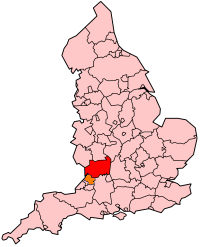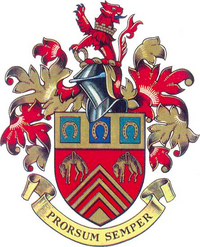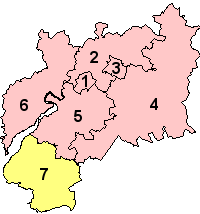Gloucestershire

Gloucestershire's Location within England |

Gloucestershire's Coat of Arms |
- Gloucester
- Tewkesbury
- Cheltenham
- Cotswold
- Stroud
- Forest of
Dean
- South Gloucestershire
(Unitary)
|
Gloucestershire
(pronounced GLOSS-ter-sher) is a county in South West England. The county
comprises part of the Cotswold Hills, part of the flat fertile valley
of the River Severn, and the entire Forest of Dean.
The county town is
Gloucester, and other principal
towns include Cheltenham,
Stroud, Cirencester,
and Tewkesbury.
When considered as
a ceremonial county, Gloucestershire borders
the preserved county of Gwent in Wales, and in England
the ceremonial counties of Herefordshire,
Oxfordshire, Worcestershire,
Warwickshire, and Wiltshire
(including Swindon).
| Geography |
| Status |
Ceremonial &
(smaller) Non-metropolitan county |
| Region |
South West England
|
Area
- Total
- Admin Council
- Admin Area |
Ranked 16th
3,150 km²
Ranked 17th
2,653 km² |
| Admin HQ |
Gloucester
|
| ISO 3166-2 |
GB-GLS |
| ONS code |
23 |
| NUTS 3 |
UKK13 |
| Demographics |
Population
- Total (2002 est.)
- Density
- Admin Council
- Admin Pop.
|
Ranked 24th
815,263
259 / km²
Ranked 21st
568,452 |
| Ethnicity |
97.3% White |
| Politics
|
| Executive |
Conservative |
| Members of Parliament |
Roger Berry
Geoffrey Clifton-Brown
Parmjit Dhanda
David Drew
Mark Harper
Martin Horwood
Doug Naysmith
Dan Norris
Laurence Robertson
Steve Webb |
History
This article describes
the History of Gloucestershire.
The English conquest
of the Severn valley began in 577 with the victory of Ceawlin at Deorham,
followed by the capture of Cirencester,
Gloucester and Bath.
The Hwiccas who occupied the district were a West Saxon tribe, but their
territory had become a dependency of Mercia in the 7th century, and was
not brought under West Saxon dominion until the 9th century. No important
settlements were made by the Danes in the district. Gloucestershire
probably originated as a shire in the 10th century, and is mentioned by
name in the Anglo-Saxon Chronicle in 1016. Towards the close of the 11th
century the boundaries were readjusted to include Winchcomb,
hitherto a county by itself, and at the same time the forest district
between the Wye and the Severn was added to Gloucestershire.
The divisions of the county for a long time remained very unsettled, and
the thirty-nine hundreds mentioned in the Domesday Survey and the thirty-one
hundreds of the Hundred Rolls of 1274 differ very widely in name and extent
both from each other and from the twenty-eight hundreds of the present
day.
Military significance
Gloucestershire
formed part of Harold's earldom at the time of the Norman invasion, but
it offered slight resistance to the Conqueror.
In The Anarchy of
King Stephen's reign the cause of the Empress Matilda was supported by
her half brother, Robert of Gloucester, who had rebuilt the castle at
Bristol. The castles at Gloucester
and Cirencester were also
garrisoned on her behalf.
In the barons' war
of the reign of Henry III, Gloucester
was garrisoned for Simon de Montfort, but was captured by Prince Edward
in 1265, in which year de Montfort was slain at Evesham.
Bristol
and Gloucester actively
supported the Yorkist cause during the Wars of the Roses.
In the religious struggles
of the 16th century Gloucester
showed strong Protestant sympathy, and in the reign of Mary, Bishop Hooper
was sent to Gloucester
to be burnt as a warning to the county.
The same Puritan leanings
induced the county to support the Parliamentary cause in the civil war
of the 17th century. In 1643 Bristol
and Cirencester were captured
by the Royalists, but the latter was recovered in the same year and Bristol
in 1645. Gloucester was
garrisoned for the parliament throughout the struggle.
Land partition
On the subdivision
of the Mercian diocese in 680 the greater part of modern Gloucestershire
was included in the diocese of Worcester,
and shortly after the Conquest constituted the archdeaconry of Gloucester,
which in 1290 comprised the deaneries of Campden,
Stow, Cirencester, Fairford,
Winchcombe, Stonehouse,
Hawkesbury, Bitton, Bristol, Dursley
and Gloucester. The district
west of the Severn, with the exception of a few parishes in the deaneries
of Ross and Staunton, constituted
the deanery of the forest within the archdeaconry and diocese of Hereford.
In 1535 the deanery of Bitton had been absorbed in that of Hawkesbury.
In 1541 the diocese of Gloucester
was created, its boundaries being identical with those of the county.
On the erection of Bristol to a see
in 1542 the deanery of Bristol was
transferred from Gloucester
to that diocese. In 1836 the sees of Gloucester
and Bristol were united; the archdeaconry
of Bristol was created out of the
deaneries of Bristol, Cirencester,
Fairford and Hawkesbury;
and the deanery of the forest was transferred to the archdeaconry of Gloucester.
In 1882 the archdeaconry of Cirencester
was constituted to include the deaneries of Campden,
Stow, Northleach north and south, Fairford
and Cirencester. In 1897
the diocese of Bristol was recreated,
and included the deaneries of Bristol,
Stapleton and Bitton.
After the Conquest
very extensive lands and privileges in the county were acquired by the
church, the abbey of Cirencester
alone holding seven hundreds at fee-farm, and the estates of the principal
lay-tenants were for the most part outlying parcels of baronies having
their caput in other counties. The large estates held by William Fitz
Osbern, Earl of Hereford, escheated to the crown on the rebellion of his
son Earl Roger in 1074. The Berkeleys have held lands in Gloucestershire
from the time of the Domesday Survey, and the families of Basset, Tracy,
Clifton, Dennis and Poyntz have figured prominently in the annals of the
county. Gilbert de Clare, Earl of Gloucester, and Richard of Cornwall
claimed extensive lands and privileges in the shire in the 13th century,
and Simon de Montfort owned Minsterworth and Rodley.
Politics
Bristol
was made a county in 1425, and in 1483 Richard III created Gloucester
an independent county, adding to it the hundreds of Dudston and Kings
Barton. The latter were reunited to Gloucestershire
in 1673, but the cities of Bristol
and Gloucester continued
to rank as independent counties, with separate jurisdiction, county rate
and assizes. The chief officer of the Forest of Dean was the warden, who
was generally also constable of St Briavel Castle. The first justice-seat
for the forest was held at Gloucester Castle in 1282, the last in 1635.
The hundred of the Duchy of Lancaster is within the jurisdiction of the
Duchy of Lancaster for certain purposes.
Gloucestershire
was first represented in parliament in 1290, when it returned two members.
Bristol and Gloucester
acquired representation in 1295, Cirencester
in 1572 and Tewkesbury
in 1620. Under the Reform Act of 1832 the county returned four members
in two divisions; Bristol, Gloucester,
Cirencester, Stroud
and Tewkesbury returned
two members each, and Cheltenham
returned one member. The act of 1868 reduced the representation of Cirencester
and Tewkesbury to one member
each.
Economy
The physical characteristics
of the three natural divisions of Gloucestershire
have given rise in each to a special industry, as already indicated. The
forest district, until the development of the Sussex mines in the 16th
century, was the chief iron producing area of the kingdom, the mines having
been worked in Roman times, while the abundance of timber gave rise to
numerous tanneries and to an important shipbuilding trade. The hill district,
besides fostering agricultural pursuits, gradually absorbed the woollen
trade from the big towns, which now devoted themselves almost entirely
to foreign commerce. Silkweaving was introduced in the 17th century, and
was especially prosperous in the Stroud valley. The abundance of clay
and building-stone in the county gave rise to considerable manufactures
of brick, tiles and pottery. Numerous minor industries sprang up in the
17th and 18th centuries, such as flax-growing and the manufacture of pins,
buttons, lace, stockings, rope and sailcloth.
Relics
Gloucester Cathedral
and Bristol Cathedral, Tewkesbury Abbey, and the church of Cirencester
with its great Perpendicular porch, are historic buildings of Gloucestershire.
Of the abbey of Hayles near Winchcomb,
founded by Richard, Earl of Cornwall, in 1246, little more than the foundations
are left, but these have been excavated with great care, and interesting
fragments have been brought to light.
Most of the old market
towns have line parish churches. At Deerhurst near Tewkesbury,
and Cleeve near Cheltenham,
there are churches of special interest on account of the pre-Norman work
they retain. The Perpendicular church at Lechlade
is unusually perfect; and that at Fairford
was built (c. 1500), according to tradition, to contain the remarkable
series of stained glass windows which are said to have been brought from
the Netherlands. These are, however, adjudged to be of English workmanship,
and are one of the finest series in the country. The great Decorated Calcot
Barn is an interesting relic of the monastery of Kingswood
near Tetbury. The castle at
Berkeley is a splendid example
of a feudal stronghold. Thornbury Castle, in the same district, is a fine
Tudor ruin, the pretensions of which evoked the jealousy of Cardinal Wolsey
against its builder, Edward Stafford, 3rd Duke of Buckingham, who was
beheaded in 1521. Near Cheltenham
is the fine 15th-century mansion of Southam de la Bere, of timber and
stone.
Memorials of the de
la Bere family appear in the church at Cleeve. The mansion contains a
tiled floor from Hayles Abbey. Near Winchcomb
is Sudeley Castle, dating from the 15th century, but the inhabited portion
is chiefly Elizabethan. The chapel is the burial place of Queen Catherine
Parr. At Great Badminton is the mansion and vast domain of the Beauforts
(formerly of the Botelers and others), on the south-eastern boundary of
the county.
Antiquities and Other Places
of interest
- Berkeley Castle,
an example of a feudal stronghold.
- Forest of Dean
- Hailes Abbey
- Sudeley Castle
- Tewkesbury Abbey
- Tyndale Monument
- Wildfowl and Wetland
Trust, Slimbridge
|






